
Acanthaceae is a family of dicotyledonous flowering plants containing almost 250 genera and about 2500 species. Most are tropical herbs, shrubs, or twining vines; some are epiphytes. Only a few species are distributed in temperate regions. The four main centres of distribution are Indonesia and Malaysia, Africa, Brazil, and Central America. Representatives of the family can be found in nearly every habitat, including dense or open forests, scrublands, wet fields and valleys, sea coast and marine areas, swamps, and mangrove forests.
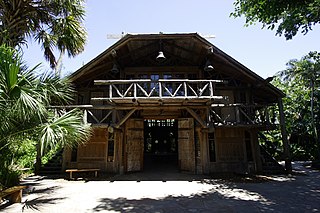
The McKee Botanical Garden is a non-profit, subtropical botanical garden in Vero Beach, Florida. It is located at 350 U.S. Highway 1, Vero Beach, Florida.

Ruellia is a genus of flowering plants commonly known as ruellias or wild petunias. They are not closely related to petunias (Petunia) although both genera belong to the same euasterid clade. The genus was named in honor of Jean Ruelle (1474–1537), herbalist and physician to Francis I of France and translator of several works of Dioscorides.

Ruellia brevifolia, the tropical wild petunia or red Christmas pride, is an ornamental plant in the family Acanthaceae. It is native to South America, from Colombia to southern Brazil and northern Argentina.

Ruellia simplex, the Mexican petunia, Mexican bluebell or Britton's wild petunia, is a species of flowering plant in the family Acanthaceae. It is a native of Mexico, the Caribbean, and South America. It has become a widespread invasive plant in Florida, where it was likely introduced as an ornamental before 1933, as well as in the eastern Mediterranean, South Asia and other parts of the eastern hemisphere.

Ruellia humilis is a species of flowering plant in the family Acanthaceae. It is native to the eastern United States. It is grown as an ornamental plant.

Ruellia jussieuoides is a species of flowering plant in the family Acanthaceae. It is a subshrub of the tropical Americas, native to central and southern Mexico and Guatemala, Nicaragua, Costa, Rica, and Panama, and Ecuador, Peru, Bolivia, and West-Central and southeastern Brazil. It is native to the Cerrado ecoregion of Brazil.
Ruellia rufipila is a species of flowering plant native west-central Brazil, where it grows in the Cerrado ecoregion.
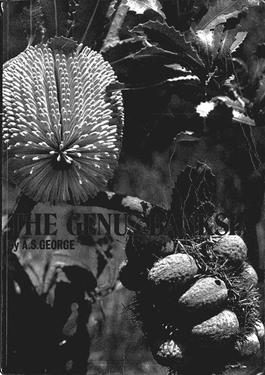
"The genus Banksia L.f. (Proteaceae)" is a 1981 monograph by Alex George on the taxonomy of the plant genus Banksia. Published by the Western Australian Herbarium as Nuytsia3(3), it presented George's taxonomic arrangement of Banksia, the first major taxonomic revision of the genus since George Bentham published his arrangement in Flora Australiensis in 1870.
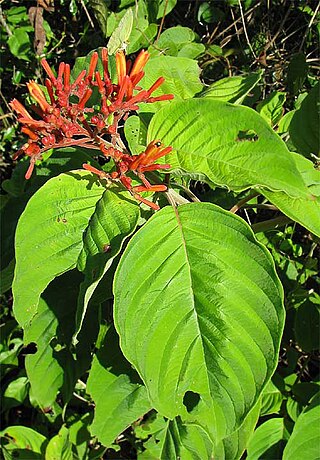
Hamelia is a genus of flowering plants in the coffee family, Rubiaceae. The name honors French botanist Henri-Louis Duhamel du Monceau (1700–1782).
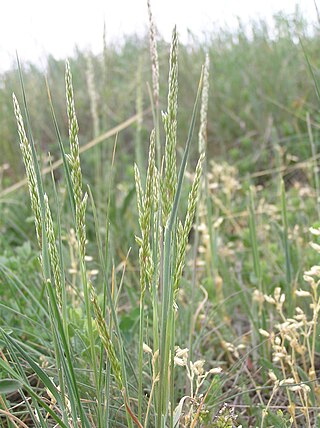
Koeleria macrantha is a species of grass known by the common name prairie Junegrass in North America and crested hair-grass in the UK. It is widespread across much of Eurasia and North America. It occurs in many habitat types, especially prairie.
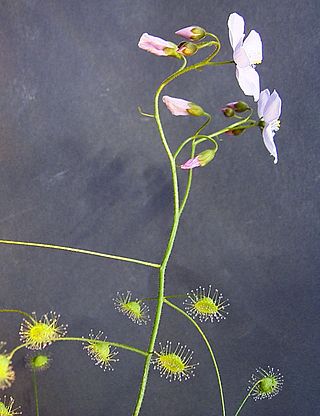
Drosera macrantha, the bridal rainbow, is a scrambling or climbing perennial tuberous species in the carnivorous plant genus Drosera that is endemic to Western Australia. It grows in a variety of habitats, including winter-wet depressions in sandy, loamy, laterite, or quartzite soils. D. macrantha produces small, cup-shaped carnivorous leaves along a long stem that can be 0.16–1.5 m (0.5–4.9 ft) high as it climbs. Its 1 in (2.5 cm) white or pink flowers emerge from June to November, blooming earlier in the more northern range.

Drosera menziesii, the pink rainbow, is an erect or scrambling perennial tuberous species in the carnivorous plant genus Drosera. It is endemic to Western Australia and grows in a variety of habitats, including winter-wet depressions, swamps, and granite outcrops in clay or peat sand soils or loam. D. menziesii produces small, circular carnivorous leaves along an undulating erect stem that can be .05–1.1 m (0.2–3.6 ft) high. Its pink flowers emerge from July to November.
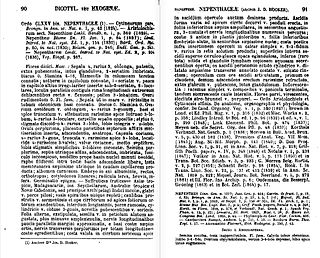
"Nepenthaceae" is a monograph by Joseph Dalton Hooker on the tropical pitcher plants of the genus Nepenthes. It was published in 1873 in the seventeenth and final volume of Augustin Pyramus de Candolle's Prodromus Systematis Naturalis Regni Vegetabilis, which was edited by Augustin's son, Alphonse. The monograph focused primarily on new discoveries from northern Borneo. Unlike most major works on Nepenthes, it included no illustrations.

Jean Ruel, also known as Jean Ruelle or Ioannes Ruellius in its Latinised form, was a French physician and botanist noted for the 1536 publication in Paris of De Natura Stirpium, a Renaissance treatise on botany.
Several plant taxa contain the word macrantha, meaning "large-flowered":

Ruellia affinis, also known as red ruellia or wild petunia, is a vine native to Brazil, which is usually used as an ornamental plant.
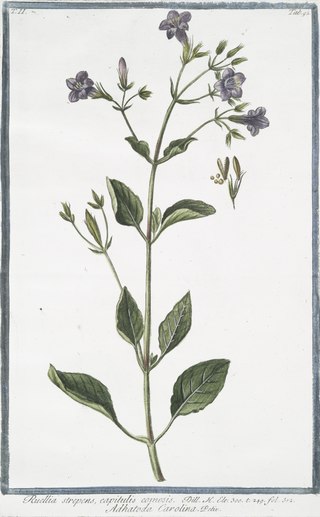
Ruellia strepens, commonly known as limestone wild petunia, limestone ruellia, smooth wild petunia, or wild petunia is a species of flowering plant in the family Acanthaceae, native to warmer parts of the central and eastern United States. A perennial herb, it prefers to grow in moist to mesic, partly shady areas such as streamsides and bottomland forests. In the garden it is hardy to USDA zone 5, and can tolerate nearly full shade.
















